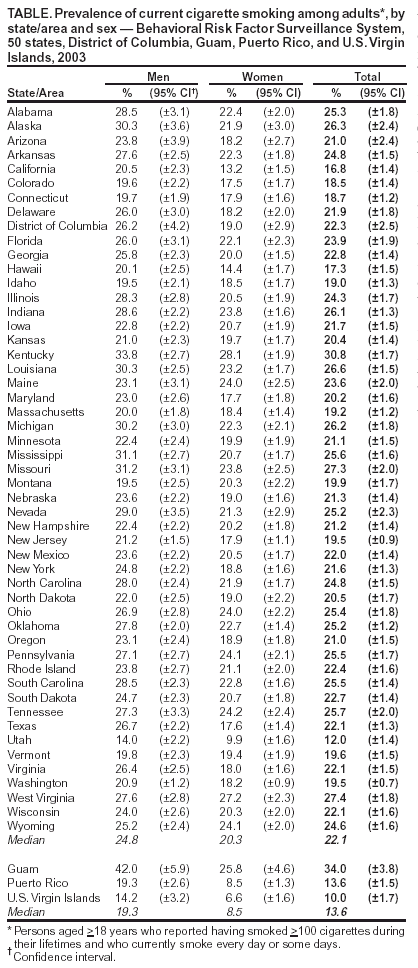 |
|
|
|
|
|
|
|
|
|
|
|
|
|
|
|
|
||||
| ||||||||||
|
|
|
|
State-Specific Prevalence of Current Cigarette Smoking Among Adults --- United States, 2003Cigarette smoking causes approximately 440,000 deaths annually in the United States (1). To assess the prevalence of current cigarette smoking among adults, CDC analyzed data from the 2003 Behavioral Risk Factor Surveillance System (BRFSS) survey. This report summarizes the results of that analysis, which indicated substantial variation in cigarette smoking prevalence in the 50 states, the District of Columbia (DC), Guam, Puerto Rico, and the U.S. Virgin Islands (USVI) (range: 10.0%--34.0%). To further reduce the prevalence of smoking, states/areas should implement comprehensive tobacco-control programs. BRFSS is a state-based, random-digit--dialed, telephone survey of the U.S. civilian, noninstitutionalized population aged >18 years. In 2003, the median state/area response rate was 53.2% (range: 34.4%--80.5%). Estimates were weighted by age and sex distributions for each state's population, and 95% confidence intervals were calculated. BRFSS respondents were asked, "Have you smoked at least 100 cigarettes in your entire life?" and "Do you now smoke cigarettes every day, some days, or not at all?" Current smokers were defined as those who reported having smoked >100 cigarettes during their lifetimes and who currently smoke every day or some days. In 2003, the median prevalence of current cigarette smoking among adults was 22.1% in the 50 states and DC (range: 12.0% [Utah]--30.8% [Kentucky]) (Table). Smoking prevalence was higher among men (median: 24.8%; range: 14.0%--33.8%) than women (median: 20.3%; range: 9.9%--28.1%) in the 50 states and DC. Smoking prevalence for both men and women was highest in Kentucky (men: 33.8%; women: 28.1%) and lowest in Utah (men: 14.0%; women: 9.9%). In areas other than the 50 states and DC, the median prevalence of current cigarette smoking among adults was 13.6% (range: 10.0% [USVI]--34.0% [Guam]). Reported by: J Bombard, MSPH, A Malarcher, PhD, M Schooley, MPH, A MacNeil, MPH, Office on Smoking and Health, National Center for Chronic Disease Prevention and Health Promotion, CDC. Editorial Note:Although the prevalence of current cigarette smoking among U.S. adults has declined, the rate of decline has not been rapid enough for the nation to achieve the 2010 national health objective of <12% of adults smoking cigarettes (objective 27-1) (2,3). The median prevalence of adult smoking decreased 1 percentage point from 2002 to 2003, and the national objective for 2010 was achieved in Utah and the USVI. The high prevalence of current cigarette smoking in most of the remaining states/areas underscores the need for increased efforts to reduce tobacco use. The findings in this report are subject to at least three limitations. First, the BRFSS survey does not sample persons in households without telephones, a population that might be more likely to smoke (4). Second, data for cigarette smoking are based on self-reports and are not validated with biochemical tests. However, self-reported data on current smoking status have high validity (4). Third, the median response rate was 53.2% (range: 34.4%--80.5%); lower response rates indicate a potential for response bias. However, BRFSS estimates for cigarette smoking are comparable with current smoking estimates from other surveys with higher response rates (5). Comprehensive tobacco control is effective in preventing and reducing tobacco use (6). CDC recommends the following evidence-based interventions as strategies within comprehensive tobacco-control programs: clean indoor air laws, telephone support quitlines, media campaigns, increased excise taxes on tobacco products, insurance coverage for cessation counseling and pharmaceuticals, and health-care system changes that support cessation (7). Substantial variation exists across states in their use of these strategies. For example, in 2002, two states offered Medicaid coverage for all recommended medication and counseling treatments for tobacco dependence, whereas 11 states covered no tobacco-dependence treatments (8). In addition, the average cost of a single pack of cigarettes (which includes state-based excise taxes) ranged from $3.10 in Kentucky to $5.54 in New York in 2003 (9). The majority of states offer telephone support quitlines, and residents of all states soon will have access to a nationwide network of quitlines. Finally, only six states (California, Connecticut, Delaware, Maine, Massachusetts, and New York) have comprehensive statewide bans in effect on smoking in indoor workplaces and public places. The more funds that states spend on comprehensive tobacco-control programs, the greater the reduction in smoking (6). However, the amount of money that states spend for tobacco control decreased 28% during the preceding 2 years to $541.1 million, which is less than 3% of the estimated $19 billion states expected to receive from tobacco excise taxes and tobacco settlement money in 2003 (10). For fiscal year 2004 (i.e., July 1, 2003--June 31, 2004), only four states (Arkansas, Delaware, Maine, and Mississippi) were investing at least the minimum per capita amount that CDC recommends for tobacco-control programs (10). Efforts and resources must be expanded if more states are to reduce smoking prevalence to <12% by 2010. References
Table  Return to top.
Disclaimer All MMWR HTML versions of articles are electronic conversions from ASCII text into HTML. This conversion may have resulted in character translation or format errors in the HTML version. Users should not rely on this HTML document, but are referred to the electronic PDF version and/or the original MMWR paper copy for the official text, figures, and tables. An original paper copy of this issue can be obtained from the Superintendent of Documents, U.S. Government Printing Office (GPO), Washington, DC 20402-9371; telephone: (202) 512-1800. Contact GPO for current prices. **Questions or messages regarding errors in formatting should be addressed to mmwrq@cdc.gov.Page converted: 11/10/2004 |
|||||||||
This page last reviewed 11/10/2004
|